Honda winners include new Civic, Indy 500
By John Gilbert
The end of April was a good time to launch the all-new, ninth-generation 2012 Honda Civic, although the end of May might have been even better. The end of May is time for the Indianapolis 500, which gathers an annual turnout of up to 400,000 spectators to the Indianapolis Motor Speedway, and millions more worldwide television viewers.
The 2011 Indianapolis 500 is the 100th running of the classic oval-track race, and while single-seat, open-wheel missiles traveling 227-mile-per-hour laps around the 2.5-mile track may seem distant to something as basic as a new compact car, the parallel is perfect. A good bet to be the top-selling compact car for the coming year would be the Civic. An even better bet to win the Indy 500 would be to pick — Honda.
That one is a cinch, because all 33 entries in the Indy 500 will be powered by Honda engines. Every single one. It is a testimony to Honda’s engineering and technology that no other company can compete with Honda in the world’s fastest race. Race reporters seem to take Honda’s participation for granted, and very few other people — including in the automotive media — seem to be aware how totally Honda dominates the Indy Car race scene. For decades, Honda’s technical superiority is only exceeded by the company’s inability to promote its superiority. Maybe that’s why nobody made the connection to trumpet the combined facts of Honda’s success in a race in which durability and efficiency are as important as speed, while introducing the Civic, the real-world icon of Honda’s applied engineering efficiency.
Unlike Honda’s monopoly at Indy, the Civic faces stiff competition, the stiffest ever in the subcompact segment since the Civic was introduced to the U.S. as a 1973 model. Traditional rivals, such as the Toyota Corolla, Nissan Sentra, and Mitsubishi Lancer, have been joined by the Mazda3 and in 2011 by a new Hyundai Elantra, Chevrolet Cruze, and Ford’s new Focus and even the smaller Fiesta.
Nonetheless, the Civic seems pretty well set to be top seller in the segment. The styling remains on the leading edge outside, and is outstanding inside, with driver’s instruments and ergonomics that are a model for the industry. The seats are good and supportive, and rise to excellent in the sporty Si version. The shape of the car enhances visability down the steeply raked hood in all models, and while looking ahead, you find it easy to also see a large digital speed readout, on a strip of electronic instrumentation just above the thick and comfortably grasped steering wheel. Look above the wheel for your speed, and looking through the wheel gives you the large tachometer and other instruments, plus a new information panel to the right that can be changed to various preferences.
It’s all very race-car like, reminding us of going back to the 1990 era, when Honda dominated Formula 1 Grand Prix racing in the hands of the late Ayrton Senna. In Formula 1, or Indianapolis racing, a driver doesn’t have a lot of time to be studying instruments, so a glance at a digital tach or speedometer must suffice. It was back then that Honda adapted its technical expertise from Formula 1 onto its production models, including a generation of Civics that ran from 1991-1995. With variable valve-timing, double-wishbone suspension, and all-wheel disc brakes, the Civic of that generation stood as the best until the 2006 model rolled out. If you get on CarSoup and find a clean 1991-95 Civic EX, it would be a perfect second family car or an offspring’s first car, regardless of miles.
No other car compares to the array of five or six different models offered by the Civic. They range from the DX that starts at $15,605 ($16,405 for the automatic version), to the LX at $17,655/$18,455, the EX at $19,705/$20,505, with the top-level version EX with navigation and leather interior for $23,455. A specially-modified HF model, tweaked for higher mileage, is priced at $19,455, and attains EPA highway estimates of 41 mpg, compared to 39 for the rest of the fleet’s 1.8-liter figures. In
addition, a sportier high-performance Si model is again offered, ranging from $22,205 to $23,905, depending on whether you choose a coupe or sedan. The Si has a larger engine, and a 6-speed stick rather than the 5-speed offered in other coupes and sedans. Those stick shifts are smooth and precise in feel and engagement.
The Civic Hybrid is upgraded considerably, switching from a nickel-metal hydride battery pack to lithium-ion, which is more compact in size and far more efficient in developing and holding electrical power. Paired with the 1.5-liter engine from the smaller Fit, the added boost brings the horsepower up to a mere 110, with 127 foot-pounds of torque, which equates to more torque at fewer RPMs. Spread through a continuously-variable transmission, the car moves with adequate power, and it has improved EPA estimates of 44 miles per gallon, whether city or highway. A Civic Hybrid base price is $24,050, and with navigation and leather, can rise to $26,750.
If that’s not enough, a natural gas version of the Civic will be coming as a production model this fall.
Design of the new Civic is not an enormous departure from the current model, which made a total and stunning design makeover and won the 2006 North American Car of the Year award for design, interior space, performance, price, fuel economy, and diversity of models. The new car has a different look from the front, taking on some of the Insight’s lower grille appearance, and it rounds off the current model’s attractive wedginess into a more rounded shape. Overall length remains the same, while the wheelbase is shortened by a couple of inches, which helps agility a bit and helps interior room quite a bit. The interior remains creatively arranged, with a dashboard that combines a personal cockpit-style for the driver, and falls away gracefully to give the front passenger surprising spaciousness.
At the car’s introduction, in Washington, D.C., we drove from our Georgetown hotel out to FedEx Field, the Redskins NFL stadium, in a loaded EX-L model, then tried out the rest of the fleet. A steady rain finally let up so we could try a couple of cone-lined, parking-lot courses. A couple of Si Coupes proved their potency and handling there. The larger 2.4-liter four-cylinder, its 16 valves driven by dual overhead-camshafts, revs freely and is well-matched to its 6-speed manual transmission. Upgraded suspension settings and larger 17-inch wheels give the Si firmer and more stable cornering capabilities, and further put to rest the common misconception that front-wheel-drive cars aren’t as fun to fling around a track as rear-drivers. In fact, on the well-moistened autocross course, a rear-drive car would have left the choice of letting up or spinning out in places where you could hammer the throttle and simply steer the Si around the curve. The Si adds distinctive sound from the exhaust tuning, and improves on the already good Civic seats with added side bolsters in the cushion and backrest.
The Si’s 201 horsepower peak at 7,000 RPMs and 170 foot-pounds of torque at 4,300 revs, up from the 140 horses at 6,500 and 128 foot-pounds at 4,300 for the normal 1.8 liter models. However, at 2.4 liters, the much larger engine drops Si fuel economy to 22 city/31 highway from the normal Civic’s 28 city/39 highway.
The 1.8-liter four, with a single overhead cam smoothly operating four valves per cylinder, remains the Civic mainstay, except for the Si and Hybrid. On a milder handling circuit, the Civic felt predictable, although it leaned a lot more in sharper curves than the Si, which was to be expected. Honda parked a new Hyundai Elantra nearby for comparison purposes, and I must say the Korean competitor had good power and actually seemed to lean less in hard cornering.
A Civic Hybrid mileage test on normal roads sent me out with James Bell, a good friend from Los Angeles, as codriver. The roadways leaving FedEx Field are as complicated as the folks downtown trying to solve the federal budget. No matter. We had zeroed the odometer and kept driving, up and down some suburban roadways until we reached the specified mileage. My fuel economy was 44.1, which I thought was OK, but a bit disappointing, because I light-footed it all the way. James drove similarly and attained 53.7 miles per gallon — an excellent reading that was third best of all. An engineer explained the discrepancy as the battery being depleted when we first got in the car, and my session recharged the battery pack, which provided more free power and thus better fuel economy during my partner’s run.
The new Civic has been improved by increasing the amount of high-strength steel to 55 percent, making the car lighter yet stronger, with a 10-percent increase in torsional rigidity. More safety technology helps the driver handle situations better. And some high-tech additions enhance that safety. Motion-Adaptive EPS coordinates with the standard antilock brakes and traction and stability controls, as well as with electric power steering to act as soon as the computer detects instability, to improve directional stability in cornering. Problems in curves come down to oversteer or understeer, and are worsened in slippery situations. Turning the wheel too much for the curve (oversteer) is detected and braking force is applied to the outside wheels, helping the driver stay on the proper trajectory. Not turning the wheel enough for a curve (understeer) is similarly offset with the Civic system suppressing engine torque to the inside wheel while also braking the inside wheels to help the driver negotiate the curve.
With such technology, and having models with capabilities ranging from the Hybrid’s real-world 50-plus mpg, to the speed, quickness and agility of the Si, and satisfactory everyday performance out of the other models in between, the Civic seems primed to hold its place atop the compact segment.
The Civic, be assured, is better than the puzzling advertising campaign from RPA, Honda’s ad agency for three decades. Television ads lacked anything resembling cleverness for the current 2011 models, but they’ve hit bottom now. First, showing ghoulish zombies and furry critters eager to drive the new Civic is supposed to indicate that you should join right in with those zombies and animated creatures in desiring a Civic. Another new campaign features the catch-phrase “To Each Their Own.” The proper phrase is “to each his own,” where “his” is accepted for gender-neutral coverage of all humanity, but RPA apparently has decided that striving for political and gender correctness overrides the need for grammatical and proper English usage.
At the post-introduction press questioning, there was some fear that the car itself could falter to meet the low-level ad scheme. Someone asked why there was only a 5-speed stick and 5-speed automatic. Honda officials said that their market research indicated that buyers didn’t care. One engineer said that combining optimum fuel economy and value, the technology to go to a 6-speed wasn’t necessary. Furthermore, there are no steering wheel paddles for manually controlling the automatic, to which the answer was that market research showed buyers didn’t use paddles. As for the stick, the engineer said that they worked hard to get the gear ratios correct to balance fuel economy and driveability.
If there had been a gong, it would have sounded right then — three times, just for the perceived value of the competition. The new Elantra offers a 6-speed in stick and automatic, the Focus and Fiesta automatics are not only 6-speed but are direct-sequential gearboxes as well, and even the Cruze offers a choice of 6-speed stick or 6-speed automatic. The decision to stay with 5-speeds for both manual and automatic leaves the Civic with last-generation technology. Also, the Elantra, the Cruze, the Mazda3 and others offer manual gates or paddles on their automatics, and whether buyers use them or not, by lacking such manual control the Civic falls short again.
Honda’s suspension engineers always have been outstanding, based on how the Civic and other Hondas handle. The independent suspension is good, and the new Civic has MacPherson struts up front and multilink geometry at the rear, both reinforced by stabilizer bars. It does the job, but as I felt the EX model lean in cornering, I couldn’t help but recall my favorite 1991-95 Civic EXes that had, standard, double-wishbone suspension on all four corners. It was right off the race car technology, and while it was expensive, it also was superb — part of what convinced me of Honda’s superior technology.
Those 1991-94 Civic EXes also had 4-wheel disc brakes, standard, and now Honda tries to suggest that using rear drum brakes with the front discs on the DX, LX, HF, Hybrid, and the natural gas models is justified. Only the Si and EX models get 4-wheel discs. I anticipate technical advancements from Honda, and such decontenting is not what I expect from my technical leader.
In addition, claiming an all-new engine gives he Si more horsepower is a bit misleading. The 2.4 engine has been used in Hondas for years. I know well of a 1994 Prelude VTEC with that engine, and it more recently powers the larger Accord sedans. Stuffing a larger-displacement engine into a smaller car seems more General Motors than Honda, which has built its reputation on over-achieving technology from smaller engines to run with larger competition. With nearly a 25 percent increase in displacement over the current 2.0-liter four, adding only 4 horsepower wouldn’t make me eager to give up that high-revving jewel of a 2.0.
The pluses far outweigh any such minuses, particularly from the ad agency’s phrase “To Each Their Own.” I thought maybe I was being too critical about it until the New York Auto Show, when Honda executive vice president John Mandel, reading a teleprompter to avoid overlooking any pertinent facts, finished his presentation by saying: “…To Each His Own.” When asked if the teleprompter actually said “his” or “their,” Mandel laughed and refused to say. He did, however, point out that his wife is an English teacher.
It was reassuring to know that literate people can rise above bad advertising. It would also be reassuring to know that Honda technology can rise above such modern twists as using market research to rationalize decontenting. Now Honda has to find a way to prevent its semi-literate catch-phrase from sending English teachers all over the country to one of the Civic’s hot, new competitors. That specific repercussion might be a sure-thing bet. Although not as certain as that the Indianapolis 500 winner will drive to the finish line in a Honda.
CTS-V is NOT your grand-dad’s Cadillac
By John Gilbert
At first touch, you know you’re in a high-performance sports coupe. Hit the ignition and a lot of power roars to life. Click the 6-speed manual shifter into first gear, let out the clutch, and as it engages, hammer the gas pedal, resulting in a tremendous surge forward — exhilarating, in fact. This is not only power, it’s supercharged power, measuring 556 horsepower and 551 foot-pounds of torque.
The steering wheel feels thick and substantial to your grip, although if it’s real leather, it is “sueded” to the point of feeling artificially fuzzy. It is easy to grip, the easier to hang onto, as you upshift smoothly into second. You get to second in what seems to be very sudden elapsed time, and while hitting the throttle again gets you up into the revs quickly before you hit third, then fourth, the power surges at each new gear and each new tap of your right toe.
Now you sweep through a curve, and the steering and suspension feel well-matched, and as the Recaro bucket seat grips your body as perfectly as your hand grips the wheel, you carve an easily prescribed line through the curve. Very impressive, and outright fun. It would have the same appeal to an aging hot-rodder as the blatant musclecars of 40 years ago, but with so much more refinement that you don’t ever consider calling it retro.
No, it is not a hot-rod in the traditional sense. Turns out, it’s a Cadillac. But not just any Cadillac, either. This is the new CST-V Coupe, a car that began life on the auto show circuit as one of those dream concepts that, it seemed,would never reach production stage, not with General Motors falling toward its bankruptcy bottoming-out a few years ago. The CST-V is what one of those hot-rodders from a previous era might demand to own if they’d grown up and become wealthy, without ever losing the memory of the thrill of hot cars.
The powertrain is behind the scenes, although it’s never too far behind anything, really. The tailpipe trumpets tip off what’s in the CTS-V, for those unaware of what the lettered badges mean. In the 2011 CTS-V, it means a 6.2-liter V8, with a supercharger fitted on to slam a force-fed blast of air into the intake manifold, sucking in large quantities of premium fuel in order to make 556 horsepower.
Who would have ever thought that Cadillac would venture into the hot-rod business? Even if they’re recovered nicely, with the government bailout loan and reorganization, we might not have foreseen the building of such high-performance rockets on the rebound. Cadillacs always have meant stately luxury cars, usually on the very large side. When the CTS came along, it was a nicely chiseled midsize car, appropriate for the era of less ostentatious conveyances.
It still fits that description of chiseled and properly downsized to midrange, but for 2011, you can find it in a couple of different derivations — a station wagon, and a coupe. Both the wagon and the coupe take the chiseled look to new heights of attractiveness. You can get it with rear-wheel drive or all-wheel drive, and while some purists will demand the rear-drive layout, having AWD makes it more attractive to those who live in the snow belt.
Then there is the CTS-V. This was aimed directly at competing with the hottest autobahn screamers from German luxury car-makers. Cars such as the BMW “M” models, Mercedes with its AMG performance branch, and Audi, with its “S” versions, have owned that segment. The CTS-V fits well, from a pure performance standpoint, as well as by looks, and handling, and price.
You’ll spend over $60,000 to obtain your own proof that a U.S. luxury car-builder can build something so very German-like. The test-drive vehicle I had for a week was $69,440 after adding over $7,000 of options, mainly the genuine Recaro butt-clinging seats, the 19-inch satin-graphite wheels, through which you can see yellow brake calipers on the usually-red Brembo brakes, and the “midnight Sapele wood trim” package, as well as the “sueded steering wheel and shifter.” The promo blurb doesn’t say where you might find “sapele” wood, or whether you must harvest it at midnight, nor does it say “suede leather,” saying only “sueded.” Somebody said it was real leather, but its fuzziness leaves me skeptical.
The suspension is exceptional, using the magnetic ride control GM came up with for its Corvette and Cadillac XLR sports cars a decade ago. It has little tiny metallic slivers floating around in a substance inside the shock absorbers, so that when the computer senses a turn, it also senses if it’s sharp or abrupt, and instantly it signals the electromagnetis shocks to snap those slivers to attention, thus firming the shock. You don’t know all that’s going on, of course, you only know that this Cadillac puts to rest the old notion that Cadillacs are so soft they have to have plenty of lean and roll to prove it. This buggy stays flat, through the tightest turns.
You can get the CTS without the “V” and it is an impressive, real-world car on its own, with a direct-injection version of the 3.6-liter V6, with its dual overhead camshafts and four valves per cylinder. That has 304 horsepower and 273 foot-pounds of torque — more than enough to zip the Coupe around, even if it does weigh 4,000 pounds.
Moving up to the CTS-V, though, will get prompt and continual notice. My son Jack, who assists me on test-drives and shoots some photos as well, noticed on his first drive around town that people noticed the car. “I was stopped twice by people who wanted to take pictures of the car,” he said. Jack’s other comment matched my impression. “There’s so much power, but it didn’t feel brutish that way some cars do,” he said. “And the transmission was great — no skip-shift.”
Two issues here. First, in GM’s “BB” days — before bankruptcy — all other GM brands used pushrod V8s and pushrod V6es, but to set Cadillac apart, its engineers developed a high-tech, 4.6-liter V8, with dual-overhead-cams and four valves per cylinder. Maybe that was just to silence the many critics, this one included, who bemoaned the fact that GM was the only major manufacturer left in the world that compromised technology for expense in every case. Using pushrods to run from the crankshaft up to the valvetrain limited the engines’ ability to rev as high, and made it work harder at fewer RPMs.The only reason was cost, by all accounts.
Cadillac later came up with the 3.6 V6, and had a perfect complement. Despite the fact that overhead cam engines cost more to build and to develop, GM allowed versions of that “Northstar” V8 to trickle down to other branches, and the 3.6 finally, and thankfully, replaced the raspy 3.8 pushrod V6es in all other lines.
When the XLR first came along as a two-seat sports car, it had the high-tech overhead cam engines, which set it apart. Even the Corvette still used the traditional old pushrod “small block” V8 it had popularized, and it was always less expensive to simply make that engine larger and larger in displacement. I once challenged Cadillac engineers that they could make the XLR more powerful than the Corvette, because they had the great potential of dual overhead cams at their disposal. Finally one high-ranking engineer said, “You just wait.” Not long after that, an amazing supercharged version of the 4.6 V8 was introduced, and the XLR indeed could challenge the Corvette for supremacy, despite having more than one full liter less in displacement.
It was, of course, extremely costly. So it is with mixed feelings that I note the engine in the CTS-V. It is a derivative of the Corvette pushrod V8, now at 6.2 liters, with pushrods instead over overhead cams. When I asked why, I was told that General Motors no longer produces the 4.6-liter Northstar V8. It has gone the way of the Dodo bird, the Oldsmobile, and the Saturn, not necessarily in that order.
GM engineers have done an amazing job of finding ways to extract enormous quantities of horsepower out of those pushrod V8s, and the Corvette now has a 7-liter version, along with the supercharging trick.
Most consumers won’t realize that when they hammer the CTS-V, leaving behind all sorts of other high-performance cars, it also leaves behind a little bit of technology. In the process, fuel economy takes a hit, too. EPA estimates are 14 miles per gallon city, 19 highway, and we couldn’t get it over 18.
The transmission is perhaps the most significant improvement. You can get a Hydramatic 6-speed automatic, but if you think front-engine/rear-drive performance cars deserve a stick shift, try the 6-speed manual. Starting with the Corvette, and finding its way to Camaro and other GM high-performance vehicles, GM engineers learned to fool the EPA fuel economy computers with something called a skip-shift. If you started up hard, the shifter went from first to second easily, but if you started up moderately, when you went to shift from first to second, the shifter would be diverted to the right and land in fourth. If you weren’t paying attention, you would just think that your giant engine had no torque anymore.
If you were paying attention, it was maddening, especially if you were like I am, and like to start out moderately, then hit second before stepping on it hard to run the revs up. Every time, I would go first to fourth, and have to wrestle the shifter back into second, accompanied by a torrent of well-chosen words. To me, it would be a deal-breaker if I’d been considering purchase of any such car.
Cadillac has gotten wise and installs an Aisin AY6 manual transmission in the CTS-V. You can rev it high or low in first, and still go right into second. Smooth and slick. Aisin, a Japanese firm, builds those transmissions in Mexico. Hooked up to the blown 6.2 V8, it is a perfect match, and you can extract all those gobs of power in evrey gear.
The CTS-V standard equipment includes Stabilitrak, GM’s name for stability control, 10-way power seats for both driver and front passenger, high-intensity discharge adaptive headlights, foglights, Bluetooth, headlight washers, front-side-head curtain airbags,
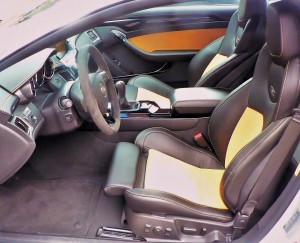
Genuine Recaro bucket seats are unparalleled, furry steering wheel is...different. (Photo by Jack Gilbert.)
rear-vision camera, and — after years of pushing its OnStar system only — now you can get an actual navigation system as well. Options include a 10-speaker Bose digital surround audio system, factory remote start, sunroof, and a 40-gig hard drive.
If you think it’s a bit much to get giant-engine power in a Cadillac Coupe, it probably is. If the practical side says it’s overdone and too much power for a quite-small coupe, it definitely is. Just remember, if the practical side gets too pushy, you could always switch to the CTS-V Wagon — a sinister-looking, low-slung station wagon that can meet any family’s daily chores to the grocery store or for hauling kids. Just remember, with the same supercharged power, the CTS-V Wagon will get the groceries or the kids home in record time.


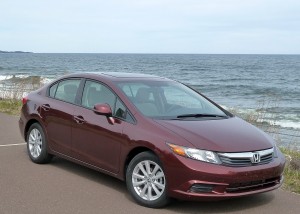
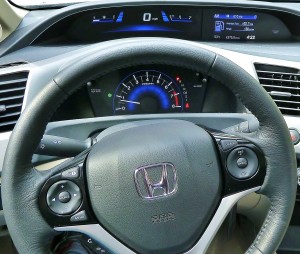
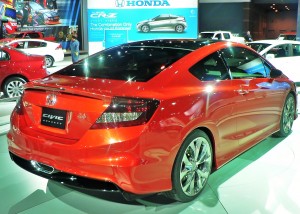
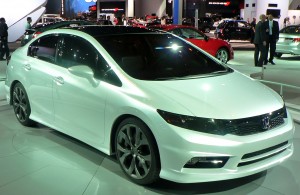
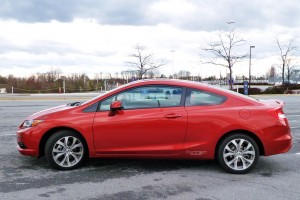
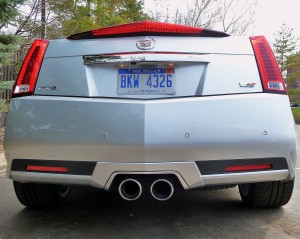
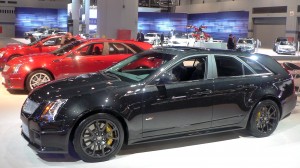
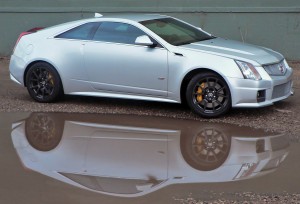
 John Gilbert is a lifetime Minnesotan and career journalist, specializing in cars and sports during and since spending 30 years at the Minneapolis Tribune, now the Star Tribune. More recently, he has continued translating the high-tech world of autos and sharing his passionate insights as a freelance writer/photographer/broadcaster. A member of the prestigious North American Car and Truck of the Year jury since 1993. John can be heard Monday-Friday from 9-11am on 610 KDAL(www.kdal610.com) on the "John Gilbert Show," and writes a column in the Duluth Reader.
John Gilbert is a lifetime Minnesotan and career journalist, specializing in cars and sports during and since spending 30 years at the Minneapolis Tribune, now the Star Tribune. More recently, he has continued translating the high-tech world of autos and sharing his passionate insights as a freelance writer/photographer/broadcaster. A member of the prestigious North American Car and Truck of the Year jury since 1993. John can be heard Monday-Friday from 9-11am on 610 KDAL(www.kdal610.com) on the "John Gilbert Show," and writes a column in the Duluth Reader.